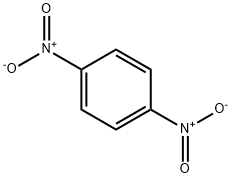??-???? ??
|
|
??-???? ?? ??
- ???
- 170-173 °C(lit.)
- ?? ?
- 183.4 °C34 mm Hg(lit.)
- ??
- 1.625 g/mL at 25 °C(lit.)
- ???
- 2.25 x 10-4 mmHg at 35 °C (Hine et al., 1963)
- ???
- 1.725 (589.3 nm)
- ???
- 150 °C
- ?? ??
- Store below +30°C.
- ???
- ???: 300ml? 1g? ????.
- ??? ??
- ?? ?? ??
- ??
- ????? ??????
- ???
- ?? ?????. (0.8g/L), 20°C??.
- Merck
- 14,3273
- BRN
- 1105828
- Henry's Law Constant
- 4.79(x 10-7 atm?m3/mol) at 35 °C (approximate - calculated from water solubility and vapor pressure)
- ?? ??
- NIOSH REL: TWA 1, IDLH 50; OSHA PEL: TWA 1 ACGIH TLV: TWA 0.15 ppm for all isomers (adopted).
- ???
- ?????? ??? ??? ? ????. ???? ??? ? ??. ???, ???, ??, ?? ??, ????? ???? ????.
- CAS ??????
- 100-25-4(CAS DataBase Reference)
??
- ?? ? ?? ??
- ?? ? ???? ?? (GHS)
| ??? ?? | T+,N,T,F | ||
|---|---|---|---|
| ?? ???? ?? | 26/27/28-33-34-50/53-52/53-39/23/24/25-23/24/25-11 | ||
| ????? | 28-36/37-45-60-61-16 | ||
| ????(UN No.) | UN 3443 6.1/PG 2 | ||
| OEB | C | ||
| OEL | TWA: 1 mg/m3 [skin] | ||
| WGK ?? | 3 | ||
| RTECS ?? | CZ7525000 | ||
| TSCA | Yes | ||
| ?? ?? | 6.1 | ||
| ???? | II | ||
| HS ?? | 29042090 | ||
| ?? ?? ??? | 100-25-4(Hazardous Substances Data) | ||
| ?? | IC50 (24-h) for river bacteria 1.27 mg/L (Yuan and Lang, 1997). | ||
| ???? ?? | KE-11935 |
??-???? ?? C??? ??, ??, ??
??? ??
light yellow powder??? ??
Clear, colorless to white crystalline solid or monoclinic crystals. Slowly turns yellow on exposure to air.??
1,4-Dinitrobenzene is used in a study to evaluate the ionization mechanism and solvent effect by novel atmospheric pressure photoionization mass spectrometry in negative ion mode for analysis of some compounds. 1,4-Dinitrobenzene can be used in synthesis of dyes and dye intermediates.??
ChEBI: A dinitrobenzene carrying nitro groups at positions 1 and 4.?? ??
Colorless to yellow solid. Sinks and mixes slowly with water.??? ?? ??
Slowly mixes with water.?? ???
All three isomers have similar properties and may react vigorously with oxidizing materials. Their reaction with nitric acid (nitration) will lead to a mixture of trinitrobenzenes possessing high-explosive properties [Urbanski, 1967, vol. 3, p. 290]. If heat and reaction conditions of the nitration are not controlled, detonation comparable to TNT may occur [Anon., J. R. Inst. Chem., 1960, 84, p. 451]. Mixture of 1,3-dinitrobenzene with tetranitromethane was found highly explosive [Urbanski, 1964, vol. 1, 592]. 1,2-dinitrobenzene is a severe explosion hazard when shocked or exposed to heat or flame. When heated to decomposition all dinitrobenzens emit toxic fumes of nitrogen oxides [Sax, 9th ed., 1996, p. 1374].????
INHALATION OR INGESTION: Headache, vertigo, nausea, vomiting, diarrhea, fever, rapid weak pulse, decreased blood pressure, cyanosis, exhaustion, hepatomegaly, jaundice, albuminurea, hematuria, visual scotomata, amblyopia and nystagmus. EYES: Irritation. SKIN: Stains skin yellow; if skin contact is prolonged, can be absorbed into blood causing same symptoms as for inhalation.Safety Profile
Suspected carcinogen. Poison by ingestion. Mutation data reported. Mxture with nitric acid is a high explosive. When heated to decomposition it emits toxic fumes of NOx. See also 0and mDINITROBENZENE????
Biological. In activated sludge inoculum, following a 20-d adaptation period, no biodegradation was observed (Pitter, 1976).Photolytic. Low et al. (1991) reported that the nitro-containing compounds (e.g., 2,4- dinitrophenol) undergo degradation by UV light in the presence of titanium dioxide yielding ammonium, carbonate, and nitrate ions. By analogy, 1,4-dinitrobenzene should degrade forming identical ions.
Chemical/Physical. Releases toxic nitrogen oxides when heated to decomposition (Sax and Lewis, 1987). 1,4-Dinitrobenzene will not hydrolyze in water (Kollig, 1993).
Purification Methods
Crystallise 1,4-dinitrobenzene from EtOH or EtOAc. Dry it under vacuum over P2O5. It can be sublimed in a vacuum. [Beilstein 5 IV 741.]??-???? ?? ?? ?? ? ???
???
?? ??
??-???? ?? ?? ??:
???? ?? ???? ?? M-?????? 1-???-3,4-?????? ??-???? ?? 2,5-?????? 1-???-2.4-?????? 2-???-4,6-????????
9,10-DINITROANTHRACENE
1,2,4,5-tetrachloro-3,6-dinitrobenzene
2,3,4,6-Tetranitroaniline
2,5-DINITROBENZOIC ACID
2,3,6-TRINITROPHENOL
2,4,5-TRINITROTOLUENE
DINITRODURENE
3,5-dichloro-1,2-dinitrobenzene
1,3-Difluoro-4,6-Dinitrobenzene/1,5-Difluoro-2,4-Dinitrobenzene
4-Chloro-3,5-dinitrobenzene sulfonic acid pottasium salt









